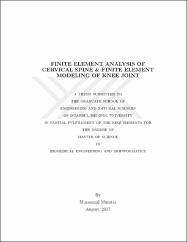| dc.contributor.advisor | Erbulut, Deniz Ufuk | |
| dc.contributor.author | Mumtaz, Muzammil | |
| dc.date.accessioned | 2021-06-01T08:29:22Z | |
| dc.date.available | 2021-06-01T08:29:22Z | |
| dc.date.issued | 2017 | en_US |
| dc.date.submitted | 2017-08 | |
| dc.identifier.citation | Mumtaz, M. (2017). Finite element analysis of cervical spine & finite element modeling of knee joint. (Unpublished master’s thesis). İstanbul Medipol Üniversitesi Fen Bilimleri Enstitüsü, İstanbul. | en_US |
| dc.identifier.uri | https://hdl.handle.net/20.500.12511/7006 | |
| dc.description.abstract | Finite Element (FE) analysis allows predicting the behavior of real life systems in controlled environment. In the recent decades, FE modeling has gained significant attention of the medical industry as well. There is no chance of error in the surgical operations. Therefore, medical professionals seek for a solution that would predict the behavior of implants inside the human body so the surgeon can opt for a best possible treatment. This thesis is based on FE modeling. This thesis can be divided into two major studies i.e. 1) FE analysis of cervical spine with implants and 2) development and validation of knee joint. For developing FE knee model, computerized tomographic (CT) scans were used to acquire accurate geometry of knee joint. The CT scans were used to construct a 3D model of knee joint in Mimics software. The geometry of all the soft tissues was obtained from literature. For the application of muscle's force, connector elements were used. The FE model of upper cervical (C0-C2) was used to study the biomechanical effect of three popular screw based atlantoaxial fixation constructs on the cervical spine. On the other hand, FE model of cervical (C2-C7) was used to study the effect of multi-level disc replacement and fusion on cervical spine. The dynamic cervical implant (DCI) was used for the disc replacement purpose. This thesis introduces a novel method for the development of soft tissues of the knee joint which makes the knee model more realistic. Besides this, effects caused by implants on spine biomechanics reported in this thesis are of clinical significance for surgeons. | en_US |
| dc.description.abstract | Sonlu Elemanlar (FE) analizi, kontrollu¨ ortamdaki ger¸cek ya¸sam sistemlerinin davranı¸sı tahminini sag˘lar. Son yıllardaki FE modellemeleri tıp endu¨strisinde o¨nem arz etmektedir. Cerrahi ameliyatlardaki hata olasılı˘gı yok denecek du¨zeyde du¨¸su¨k olması gerekmektedir. Bu nedenle, tıp uzmanları, cerrahlar i¸cin mu¨mku¨n olan en iyi tedaviyi se¸cebilmesi i¸cin insan vu¨cudundaki implantların davranı¸sını o¨ng¨orecek bir ¸c¨ozu¨m arayı¸sındadır. Bu tez, FE modellemesi ic¸eren iki ¸calı¸smadan olu¸smaktadır. Bu ¸calı¸smalar; Implantlarla servikal omurganın FE analizi ve 2) diz ekleminin geli¸simi ve ge¸cerlilig˘i. FE diz modelinin geli¸stirilmesi ic¸in diz ekleminin dog˘ru geometrisini elde edilmesi gerekmektedir. Bunun i¸cin bilgisayarlı tomografik (BT) taramalar kullanılmı¸stır. BT taramaları, Mimics yazılımında bir diz eklemi 3 boyutlu modeli olu¸sturmak i¸cin kullanılmı¸stır. Tu¨m yumu¸sak dokuların geometrisi ise literatu¨rden elde edilmi¸stir. Kas kuvvetinin uygulanması i¸cin ba˘glantı elemanları kullanılmı¸stır. Servikal omurgadaki atlantoaksiyel fiksasyon yapılarının u¨¸c yapılı vidaya dayalı biyomekanik etkisini incelemek i¸cin u¨st servikal FE modeli (C0-C2) kullanılmı¸stır. ¨ Ote yandan, c¸ok seviyeli disk replasmanı ve servikal omurga u¨zerine fu¨zyonun ¸calı¸sması i¸cin servikal (C2-C7) FE modeli kullanılmı¸stır. Disk deg˘i¸stirme amacı i¸cin dinamik servikal implant (DCI) kullanılmı¸stır. Bu c¸alı¸sma diz ekleminin yumu¸sak dokularının geli¸stirilmesi ic¸in diz modelini daha ger¸cek¸ci hale getiren yeni bir yo¨ntem ortaya koymaktadır. Bunun yanında, belirtilen omurga biyomekanig˘inde implantların neden oldu˘gu ¨ozellikler cerrahlar i¸cin klinik ¨onem arz etmektedir. | en_US |
| dc.language.iso | eng | en_US |
| dc.publisher | İstanbul Medipol Üniversitesi Fen Bilimleri Enstitüsü | en_US |
| dc.rights | info:eu-repo/semantics/openAccess | en_US |
| dc.subject | Finite Element | en_US |
| dc.subject | Knee Biomechanics | en_US |
| dc.subject | Cervical Spine | en_US |
| dc.subject | Atlantoaxial Fixation | en_US |
| dc.subject | Sonlu Elemanlar | en_US |
| dc.subject | Diz Beyomekaniği | en_US |
| dc.subject | Servikal Omurga | en_US |
| dc.subject | Atlantoaksial Fiksasyon | en_US |
| dc.title | Finite element analysis of cervical spine & finite element modeling of knee joint | en_US |
| dc.title.alternative | Servikal omurun sonlu eleman analizi & diz ekleminin sonlu eleman modellemesi | en_US |
| dc.type | masterThesis | en_US |
| dc.department | İstanbul Medipol Üniversitesi, Fen Bilimleri Enstitüsü, Biyomedikal Mühendisliği ve Biyoenformatik Ana Bilim Dalı | en_US |
| dc.relation.publicationcategory | Tez | en_US |


















